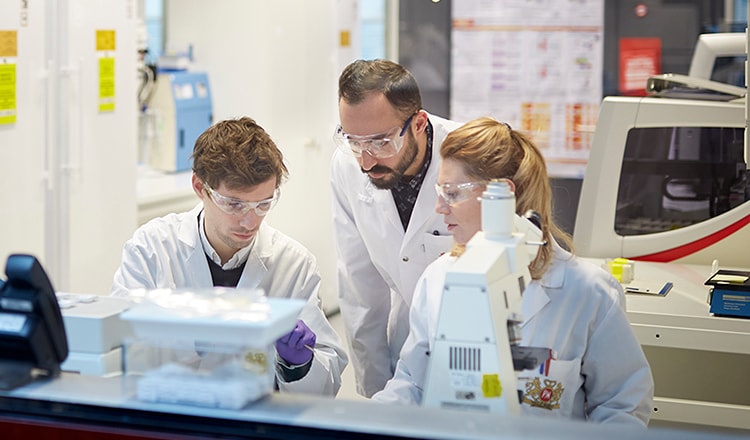There are more than a billion smokers in the world today. Their best choice is to quit tobacco and nicotine altogether, but many don’t.
At Philip Morris International, we believe smoke-free products can play a pivotal role in switching those adults who would otherwise continue smoking away from cigarettes and other combustible tobacco products—the most harmful forms of nicotine consumption.
Policymakers around the world are increasingly recognizing the importance of these scientific innovations—enabling adult smokers to access better alternatives, and accurate information about them.
Yet, confusion about these new products—as well as disinformation designed to cast doubt on the scientific substantiation behind them—may be preventing many adult smokers who wouldn’t otherwise quit cigarettes from making a better choice.
Here, we pick the top seven questions adults are asking and provide fact-based answers.
1. What is in cigarette smoke?
The burning process that releases the tobacco flavors and nicotine also produces over 6,000 chemicals, of which about 100 have been identified by public health authorities as causes or potential causes of smoking-related diseases.
2. How hot does a cigarette burn?
When burning takes place, the temperature in a cigarette can rise above 800 °C at the tip. These temperatures trigger the burning and production of smoke, which contains over 6,000 chemicals (including around 100 identified by public health authorities as harmful or potentially harmful).
3. What are smoke-free alternatives?
Smoke-free products—such as e-cigarettes, heated tobacco products, and oral nicotine products—generally provide nicotine, but do not burn tobacco and hence do not generate smoke or ash. They are alternatives to cigarettes for adults who would otherwise continue smoking.
A growing number of scientists, public health experts and governments acknowledge the role they can play in addressing the global public health issues of smoking.
Why?
Everyone knows that smoking is harmful, however what may be less known is that the high levels of harmful chemicals in the smoke of a burning cigarette are the primary cause of smoking-related disease, not nicotine.
These alternatives are not risk-free and contain nicotine—which is addictive. But if scientifically substantiated and manufactured under appropriate quality controls, they are a much better choice for adults than continued smoking.
As nicotine is one of the reasons why people smoke (along with factors such as taste and ritual), it plays a key role in the successful adoption of smoke-free products and its presence can help adults who would otherwise continue smoking to switch to better alternatives.
- Heated tobacco products (also known as heat-not-burn products) heat tobacco (in some cases these may be specially designed tobacco sticks) generating a nicotine-containing vapor.
- E-cigarettes (also known as vapes or e-vapor products) vaporize an e-liquid solution containing nicotine and flavors when a user draws on it.
- Oral nicotine products such as snus or nicotine pouches are placed between the gum and the cheek or upper lip. Snus consists of ground tobacco mixed with water, salt, and flavoring agents. It can be loose or in small portion pouches. Its use does not involve burning or inhalation of an aerosol.
Thanks to developments in science and technology, a range of smoke-free alternatives exist today for adults who don’t quit tobacco and nicotine altogether — and they deserve access to, and accurate information about them.
4. Are smoke-free products such as heated tobacco products or e-cigarettes a better alternative to cigarettes?
If scientifically substantiated and produced under appropriate quality controls, smoke-free products are a much better choice for adults who would otherwise continue smoking than cigarettes.
The burning of tobacco produces the vast majority of harmful chemicals in cigarette smoke. By eliminating the burning process—as is the case with smoke-free alternatives—the levels of harmful chemicals generated can be significantly reduced compared with cigarette smoke.
Whether a product reduces emissions of harmful chemicals compared to cigarette smoke has to be scientifically assessed in each case.
5. Are PMI’s smoke-free products risk-free?
No. PMI’s smoke-free products are not risk-free and they provide nicotine, which—although not the primary cause of smoking-related diseases—is addictive and also not risk-free. The best choice for any smoker can make is to quit products containing nicotine and tobacco completely.
6. What is the role of nicotine in smoke-free alternatives to cigarettes?
Nicotine is one of the reasons people smoke, along with other factors, such as taste and ritual. To enable adult smokers to successfully switch from cigarettes to smoke-free alternatives, these products generally need to contain nicotine.
To be clear, the best choice any smoker can make is to avoid nicotine altogether. Smoke-free alternatives are only for those adults who would otherwise continue smoking.
Although it’s not the primary cause of smoking-related diseases, certain people should not use nicotine. Minors should not have access to tobacco or nicotine products. These products should not be used by non-nicotine users during pregnancy or while breastfeeding. They should also not be used by people with certain health conditions, such as severe high blood pressure, heart disease, diabetes, and those who are epileptic or who experience seizures.
7. What evidence is there that heated tobacco products are a better alternative to cigarettes?
To assess whether switching to our smoke-free products results in a significant reduction in the risk of harm compared with continued smoking, we follow a rigorous scientific assessment program. This program applies well-recognized practices in toxicology, as well as an innovative Systems Toxicology-based approach to risk assessment.



